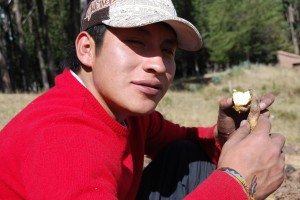Baking Potatoes in the Earth at the Solstice
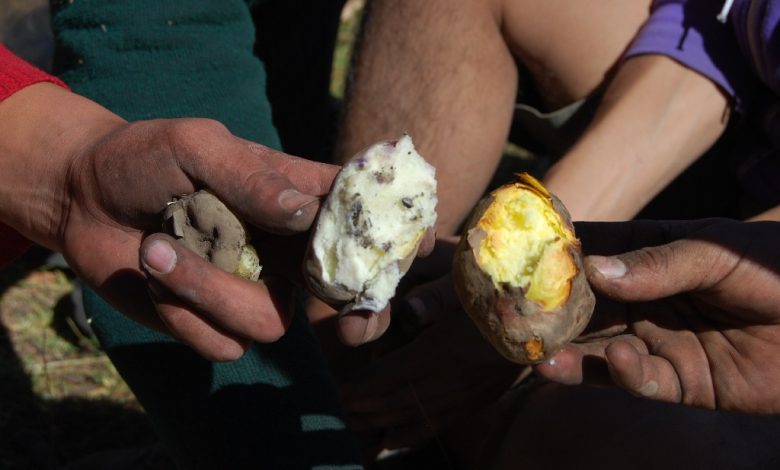
Do you like baked potatoes? There really is something delectable about their crispy outer skin and the softness of their flesh inside. Well, this next week is when people in Cuzco celebrate the season by making baked potatoes in a particular way, known as huatia (whát-ee-ya), that is rich not only with flavor but with meaning.
June, around the time of the solstice, is the high time of festivals in Cuzco. The earth is resting now, people say. It has given its produce, the rains have gone away, and it rests. But this is also a time when it is important to honor it and take care of it so that when it comes back into greenery, when the rains return, it will produce.
But this is also a time, traditionally, when offerings to the sun would be made, since the days reach their shortest point in June and start getting longer again.
As a result, this is the month of Inti Raymi, the Inca’s high celebration of the sun. It was recreated in the twentieth century and has become a major event in Cuzco’s life, engaging much of the population in one way or another.
After the Spanish came, and the historic Inti Raymi ceased to be performed, a Christian ritual took much of its place. Called Corpus Christi it celebrates the Holy Eucharist, the body of Christ. But in Cuzco it is also a time when the holy figures from the Cathedral make their way through neighborhoods and mobilize much of the population to celebrate them. Dance troupe after dance troupe, for almost twenty hours, come from Cuzco and surrounding communities to perform in a massive parade through town and around the main square. In many ways, it is the peak of Cuzco’s ritual cycle.

As if those two were not enough, Cuzco is also celebrating The Days of Cuzco, its annual celebration of self. For the last few days, the institutions of Cuzco, its schools and businesses, have danced through the main square performing folkloric dances that represent traditional life.
It is a busy and exciting time. Not surprisingly, it is associated with food. As many people say, these days one just feels a desire to eat huatia. It is as if the need arose with the solstice and the resting earth.
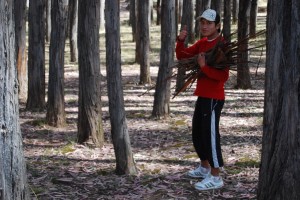
Huatia is not about wrapping potatoes in tin foil and tossing them in a hot oven. Rather it is a very ancient custom that was described by the chroniclers of the Spanish conquest and is associated with the potato harvest, the resting earth, and this season of festivals.
People say that though one can make huatia other times, it just tastes different at this time of the year. The earth is dry and that imparts a different flavor as does the season.
To make huatia, one must lift clods of earth to make an oven. First, though, one lifts some dirt and lets it slide from the fingers to show the direction of the breeze. The door of the clod oven should face the source of the breeze.
Then clods are formed very carefully, one by one, while someone holds them in place, to make an arch which can stand by itself. This will be the doorway which will face the blowing air.
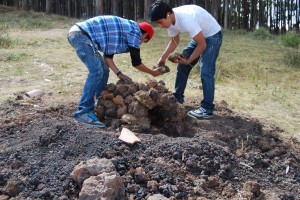
In a circle to its back a row of clods is placed. Then one by one the walls of the oven are lifted. The hardest part is that of inclining them slowly inward so that one can make a dome to close the oven. Needless to say, this is an art that people grow up doing and so know how to make clods form into a closed dome.
After the oven is formed, its holes are chinked and dirt is poured over it to try to seal it.
In the meantime people will gather sticks and bark to make a fire. One can also used dried animal manure.
The fire is lit and burns hotly for at least a half hour to bring an intense heat to the inside of the oven. The smoke from the fire blackens the oven while the flames glow intensely within. Though no one said this to me, it is as if the sun had entered a cave in the earth where it glows brightly and with burning heat.
Once people feel the oven is hot enough, or when the dome collapses, people rake the coals into a bed and than start placing potatoes and other tubers, such as ocas (oxalis) and sweet potatoes among the very hot embers and clods. They tear down more of hte oven and add more produce, until they have made a mound shaped like the belly of a woman in late pregnancy. They make sure all the produce is well covered and the cover the mound with more dirt so that no more smoke is rising.
The name huatia is said to come from this act of collapsing the oven to cover the produce.
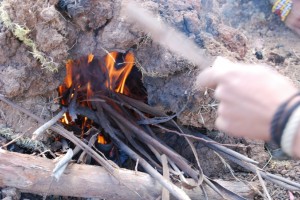
Then people wait. A half an hour. “Is it time yet?” “No it still has ten minutes” …
When everyone decides it is time they rake the dirt aside carefully to discover the cooked tubers, just like in the harvest itself. When a tuber comes to the surface, especially the first, people may comment. “Look at it. It is crisp and well cooked.”
While some people cannot resist eating the first tubers to come out, generally they are set aside in a pile.
Once they are all pulled from the earth, people gather in a circle around the pile, sitting on the ground. They will pull out canister or bag with green hot sauce made from huacatay, peppers and roasted peanuts as well as slice a round of local cheese.
Then they begin to eat, saying they must not get up until they finish all the potatoes.
The potatoes and oca are indeed delicious. Peru has hundreds, if not thousands of different varieties of potatoes, each with a different texture, color, and flavor. As the variety comes from the earth, they are often commented on.
You have never had a baked potato unless you have had one of these Peruvian potatoes pulled fresh from the earth, hot and crispy, to dip in the uchukuta, the hot sauce and lift to your mouth.
People make huatia in groups, whether family groups or groups of friends, as we from Cuzco Eats did. It is a way of celebrating and recognizing these social ties at this critical time of the year when the earth and sun are weak. By eating in the group one strengthens them.
June 24th, a week from today, the hill above Cuzco where the ancient temple fortress Sacsayhuaman still stands, though incomplete, thousands of tourists willg ather to watch the massive pagent of Inti Raymi, with its early twentieth century, indigenist romanticism. Around them, many more thousands of Cuzqueños will gather in family groups and groups of friends to make huatia.
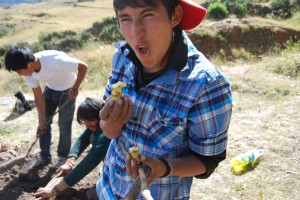
The ceremony of huatia will enclose the reinvented Inti Raymi — of which many Cuzquieños are tired — with a more indigenous, ancestral ritual meal to reinvigorate the earth and make the sun grow again. And grow it shall, as if it burst from an earthen oven to fill the sky again.
(Many thanks to Walter, Eduardo, Brayan, Fernando, and Dayal who took time to make and share a huatia with me so we could write this article.)
